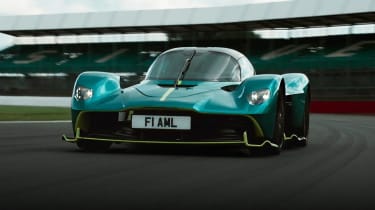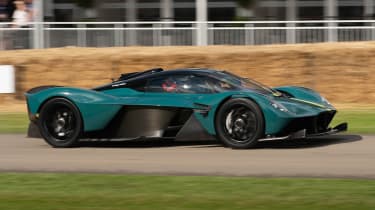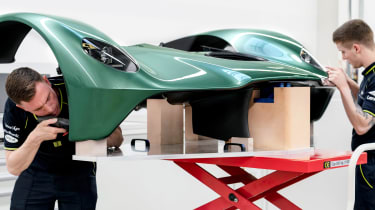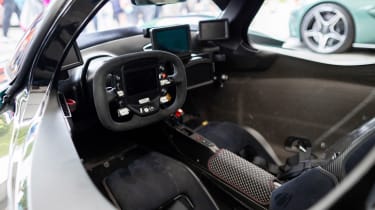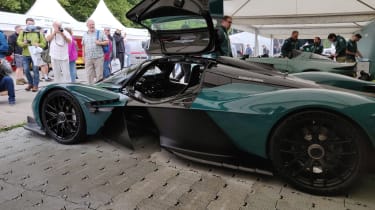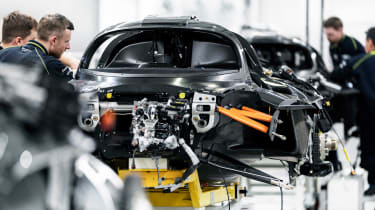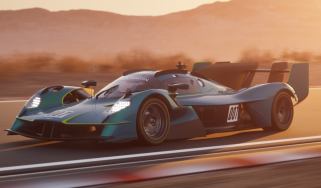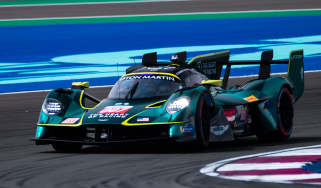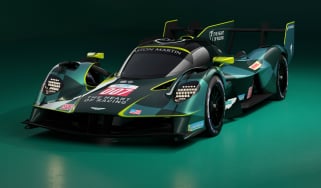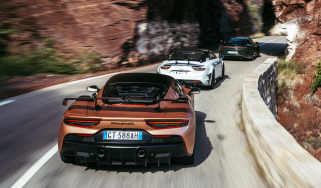The Aston Martin Valkyrie has broken the Silverstone lap record
As customer deliveries continue, the Aston Martin Valkyrie hypercar has proven its worth with a record-breaking lap around Silverstone
Over three years since production began, Aston Martin has finally shown us what the Valkyrie is made of with a record-breaking lap. Piloted by Le Mans winner and chief test driver Darren Turner, the flagship hypercar lapped Silverstone’s GP circuit quicker than any road car that came before it.
On familiar ground surrounding its Silverstone test facility, Aston Martin managed to shave a whole 10 seconds off the previous 2:06.83 road car record, set in 2022 with JCR's modified Porsche 911 GT2 RS. A stunning 01:56:42 time makes the Valkyrie the first road car to dip below the 2 minute mark, even putting it in the realm of track-only racers.
> Aston Martin Valkyrie review: a new realm of hypercar performance
While still quite some way from the 1:27.097 outright record set by Max Verstappen in 2020, this time puts it ahead of the fastest GT3 car record – a Lamborghini Huracan GT3 Evo currently holds that title with a 1:58.165 time, set in 2019. While these track-only racers have under half the power of the Valkyrie, their extreme aero packages and slick tyres don’t have to conform with the restraints of road homologation, making them extremely capable despite the power disadvantage.
Following the record run, Turner said: ‘The acceleration and top speed is way beyond anything that I’ve raced at Le Mans. With active aero, and the car’s ability to optimise downforce as you accelerate, the speed just keeps climbing.’ Onboard video reveals that the Valkyrie touches 170mph on the Hamilton straight and 180mph on the Hangar straight, proving just how potent it is. Given it was a completely standard car (tyres included), Turner revealed that they even drove the car on the road following the record.
Though the surface was dry during the attempt, Turner says that recent rain and a motorcycle event had left it in less-than-ideal condition for the attempt. He added: ‘The car performed brilliantly. I’m not sure I had anything more to give, but maybe on a day that was kinder with the conditions we could find a few more tenths if not more.’
With the Red Bull RB17, Adrian Newey’s latest hypercar project, claiming Formula 1 lap times, it will be fascinating to see how this new car compares…
The Aston Martin Valkyrie: the story
The Valkyrie was conceived at a time when Aston Martin and Red Bull Racing were partners and not opposing race teams in the F1 paddock, yet the partnership has continued despite the very different circumstances. This application of cutting-edge F1 tech was blended in the Valkyrie’s development alongside a desire to go racing at Le Mans in the LM Hypercar class, but with new leadership under Lawrence Stroll, this exercise has been cancelled in order to focus on the F1 team.
Yet this F1 connection is arguably more important, because it will go head-to-head with the Mercedes-AMG Project One – a pet project of former AMG boss (and now Aston Martin boss) Tobias Moers that has seen its own delays and setbacks in the development phase due to its directly F1-derived powertrain.
Chassis and aerodynamics
The Valkyrie is a two-seater supercar but occupants sit with their feet above their hip point – just like an F1 or LMP car. It’s made from carbonfibre, the composition and thickness of which (it varies depending on strength requirements) is defined by Newey and Red Bull Advanced Technologies.
The huge power output comes from a high-revving, normally aspirated V12 with KERS, that’s completely bespoke and shares nothing with the current Aston Martin V12 we know from the likes of the Vanquish. Nor is it related to the One-77 or Vulcan engines.
Freed from the constraints of racing regulations Newey devised a car that looks set to instantly make cars like LaFerrari, P1 and 918 Spyder seem archaic, heavy and, unbelievably, rather slow. It has downforce levels similar to an LMP1 car, and can achieve 3.3G of lateral acceleration.
While downforce has always been the core design deliverable, the team also had the challenge of finishing the Valkyrie with the sort of details befitting an Aston Martin car of this price tag. One example is the front badge. Deemed too heavy when made from the traditional enamel, Aston Martin has instead designed a chemical-etched aluminium badge just 70 microns thick. At about 30 per cent thinner than a human hair, the badge is then covered in a thin layer of clear lacquer to protect against the elements.
The headlights are also very specialised and are 30 to 40 per cent lighter than other units available to Aston Martin. The team stripped back the components found inside a normal headlight, directly mounting the essential elements to a single aluminium frame and removing all the shrouding one would usually see in a headlight unit.
The Valkyrie interior was perhaps the biggest challenge, though, as designers had to work within the strict packaging allowances dictated by the carbonfibre tub. Like Ferrari did in its LaFerrari, Aston Martin has mounted the seats directly to the tub to save space, while all the controls have been placed on an F1-inspired steering wheel.
The Valkyrie also continues Aston Martin’s tradition of names beginning with V – such as Vanquish, Volante and Vantage. Reichman said: ‘Aston Martin model names have deep meaning. They need to inspire and excite. The Aston Martin Valkyrie is an incredibly special car that demands an equally remarkable name; an uncompromising car that leaves nothing in reserve. The connotations of power and honour, of being chosen by the Gods, are so evocative, and so pertinent to a car that only a fortunate few will ever experience.’
Powertrain
Aston Martin drafted in Cosworth to help develop the hybrid powertrain. The British outfit was tasked with building the engine and admitted that the Valkyrie featured the most powerful naturally aspirated road car engine yet, with 1000bhp. Sourced from a 6.5-litre V12 augmented by a ‘lightweight hybrid battery system’, the electric element is configured in a KERS-style boost system akin to those equipped in Formula 1 cars.
The engine is capable of producing its peak 1000bhp output at 10,500rpm, 545lb ft of torque at 7000rpm and hits redline at a rather ridiculous 11,100rpm. Aston Martin says that the majority of the engine’s internal components are machined from solid material, including F1-spec pistons, making for an exceedingly light engine at just 206kg - Cosworth’s 3.0 litre V10 F1TM engines weighed 97kg, if scaled-up to 6.5 litres they would weigh more, at 210kg. As if 1000bhp wasn’t enough, performance figures are further boosted by a battery hybrid system.
Aston Martin hasn't been shy in its search for project partners. Ricardo is engineering a bespoke seven-speed paddleshift gearbox, while Rimac developed the hybrid battery system. Construction of the carbonfibre Monocell is taken care of by Multimatic, Alcon and Surface Transforms supply the brakes, Bosch delivers the ECU, traction control and ESP systems and Wipac is handling the full LED head and tail lights.
Adrian Newey said of the technical partners supporting the AM-RB 001 project: ‘Much like Formula 1, designing, engineering and building a car like the AM-RB 001 is a massive team effort. To achieve great things you need to surround yourself with the best people.
‘Experience, creativity, energy, diligence and perfectionism are absolute must-have qualities in every area of the project. Having great technical partners such as those working with us is both reassuring and motivating. Together we aim to produce an innovative piece of engineering art.’
The Aston Martin Valkyrie's tyres
A car sure to be among the most extreme ever made available for the road needs tyres to suit, and at the Geneva motor show Michelin was confirmed as the official tyre partner for Aston’s hypercar.
Surprisingly, the tyres chosen for the Valkyrie aren’t some entirely new type designed to Adrian Newey’s exacting requirements, but a set of Michelin Pilot Sport Cup 2s – a tyre we’re more than familiar with from dozens of other sports and performance cars.
There’s a good reason for that, of course: there’s currently no better tyre for high-performance road and track work, but the Valkyrie is sure to put the Cup 2s to their greatest test yet. Up front, 265/35 R20 rubber will be used, and 325/30 R21 at the rear – a staggered set-up common to mid-engined supercars – and Aston Martin has kept unsprung weight to a minimum by wrapping the rubber around 20x9.5-inch and 21x11.5-inch magnesium centre-lock wheels.
